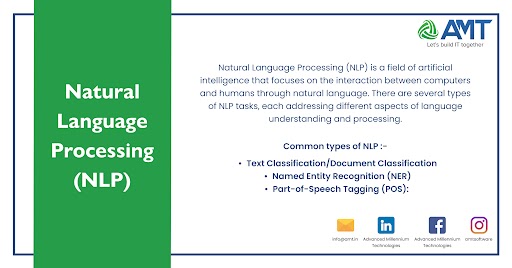Natural Language Processing (NLP) is a field of artificial intelligence that focuses on the interaction between computers and humans through natural language. There are several types of NLP tasks, each addressing different aspects of language understanding and processing. Here are some common types of NLP:
- Text Classification/Document Classification: Assigning predefined categories or labels to text documents. This is often used for tasks like spam detection, sentiment analysis, and topic categorization.
- Named Entity Recognition (NER): Identifying and classifying entities (such as names of people, organizations, locations, dates, etc.) in text.
- Part-of-Speech Tagging (POS): Assigning grammatical parts of speech (e.g., noun, verb, adjective) to each word in a sentence.
- Sentiment Analysis: Determining the sentiment expressed in a piece of text, such as positive, negative, or neutral. This is commonly used in social media monitoring, customer feedback analysis, etc.
- Machine Translation: Translating text from one language to another using machine learning algorithms.
- Text Summarization: Generating a concise and coherent summary of a given document or piece of text.
- Speech Recognition: Converting spoken language into written text, allowing computers to understand and process spoken words.
- Coreference Resolution: Identifying when two or more expressions in a text refer to the same entity.
- Question Answering: Understanding and answering questions posed in natural language. This can range from fact-based questions to more complex reasoning tasks.
- Language Modeling: Developing models that predict the probability of a sequence of words, which is the foundation for many NLP tasks.
- Conversational Agents/Chatbots: Creating systems that can engage in natural language conversations with users.
- Semantic Role Labeling (SRL): Identifying the predicate-argument structures in a sentence, including identifying the roles played by different words.
- Dependency Parsing: Analyzing the grammatical structure of a sentence to identify the relationships between words.
- Topic Modeling: Identifying topics present in a collection of text documents.
- Intent Recognition: Identifying the intent or purpose behind a user’s input, commonly used in chatbots and virtual assistants.
These tasks often overlap, and advancements in one area can contribute to improvements in others. NLP is a dynamic and evolving field with ongoing research and development.
Above is a brief about the Types of Natural Language Processing. Watch this space for more updates on the latest trends in Technology.
